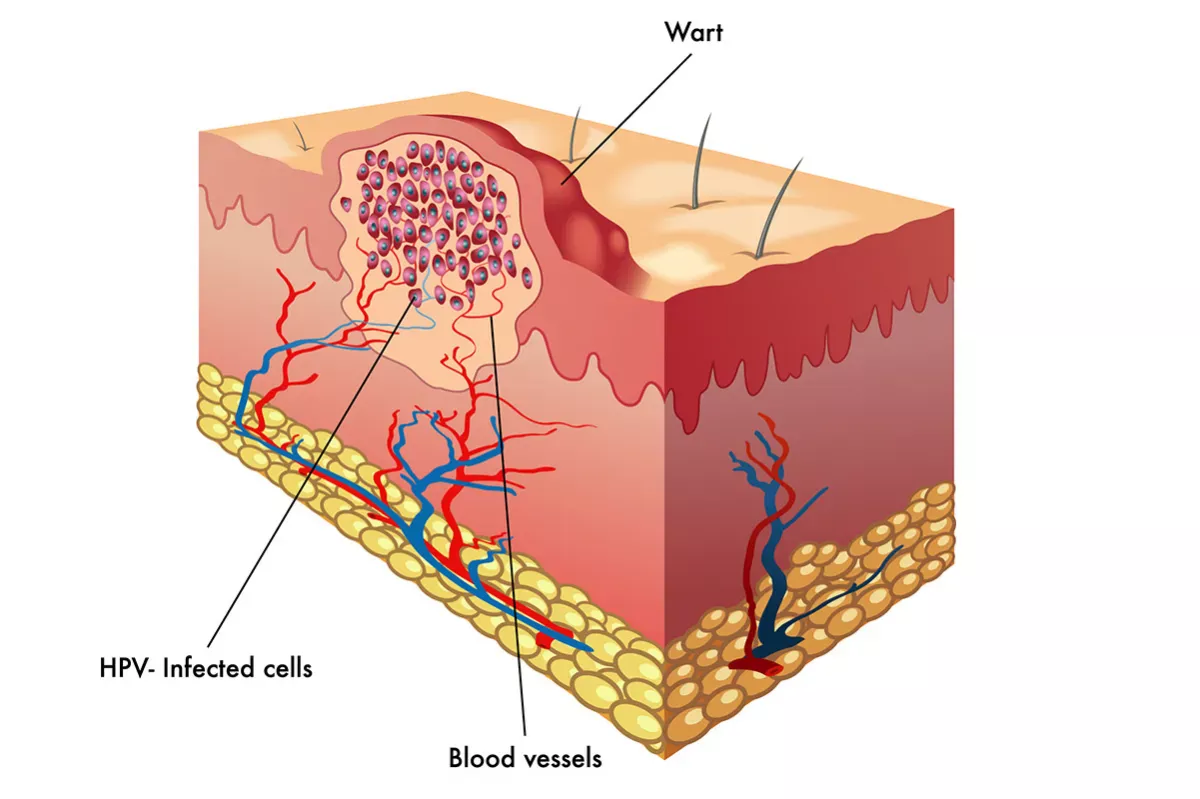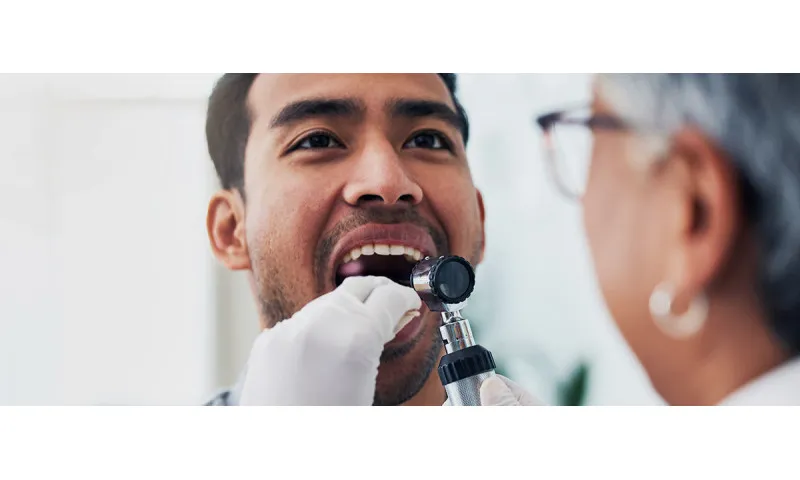The most important facts in brief
- Transmission: HPV is transmitted sexually - infection can occur during the first sexual contact.
- Course: 90 percent of HPV infections are asymptomatic and heal on their own within two years.
- HPV types: HPV viruses are divided into low-risk types, which can cause warts in the genital and oral areas, and high-risk types, which can cause precancerous lesions - especially cervical cancer.
- Diagnosis: Both the Pap smear and the HPV test examine cell changes on the cervix; alternatively, there is a blood test.
- Treatment: There is no drug against HPV; for low-risk types, the warts are treated, high-risk types must be observed so that precancerous lesions can be removed early.
- Prophylaxis: HPV vaccination offers protection against the most dangerous HPV types; condoms do not reliably protect against infection.
Definition: HPV - What is it?
HPV is the abbreviation for human papillomavirus and refers to a group of viruses that are sexually transmitted. There are more than 200 different types of HPV. Most of them are harmless and do not show any symptoms during infection. An HPV infection does not automatically mean that you will get sick: 90 per cent of infections heal by themselves within two years. However, if the infection does not clear up on its own, it is called a persistent infection.
Depending on the HPV type with which the affected person has been infected, genital warts or precancerous lesions can develop - if these are not treated, they can develop into malignant tumours. So-called low-risk types are responsible for the harmless but annoying warts (also called genital warts), while high-risk types increase the risk of cervical cancer and other types of cancer - especially in the genital area and in the mouth and throat. At least 14 of the currently known HPV types increase the risk of cancer.
Frequency
Human papillomaviruses are very widespread: 85 to over 90 percent of sexually active people become infected at least once in their lifetime. HPV occurs most frequently in sexually active people under 25.
Causes: HPV and sexuality
The human papilloma virus is primarily transmitted from person to person through direct contact. In contrast to other viral infections, HPV is not usually passed on via droplet or smear infection through body fluids, but through direct skin or mucous membrane contact. Even tiny skin flakes are sufficient for infection. The viruses find their way into the body through tiny cracks that are often not visible or noticeable. You can be repeatedly infected with HPV.
The risk of infection is particularly high during sexual activities with a lot of physical contact:
- Petting
- Vaginal intercourse
- Anal sex
- Oral sex
Human papilloma viruses can also be transmitted through kissing; however, the risk is lower.
Good to know:
Although human papilloma viruses are mainly transmitted through sexual intercourse, infected people can be deferred for blood donations. If you have tested positive for HPV and would like to donate blood, you can get advice from the blood donor service beforehand.
Do I have to tell my partner?
If you know that you are HPV positive, you should also inform your partner so that he or she can be tested accordingly. If you are a high-risk type, regular screening is important so that precancerous lesions can be detected and treated early.
How long is HPV contagious?
HPV is contagious for as long as an infection exists - in most cases for a maximum of two years. In concrete terms, this means that even if you do not notice the HPV infection, you can still infect your sexual partners with HPV.
Transmission at birth
It is especially important to know for women who are HPV-positive during pregnancy: Human papillomaviruses can also be transmitted to the newborn during birth. In a Canadian study, more than 1,000 pregnant women were examined for this. In about 40 percent of the participants, the vaginal smear was HPV-positive. Two-thirds of the HPV-positive women were infected with at least one high-risk type. However, only about seven percent of newborns were HPV-positive by the third month of life. After six months, no more HP viruses could be detected in the babies. These results show that transmission to the baby at birth is not permanent. So the birth does not necessarily have to be by caesarean section.
Symptoms
HPV infections usually pass without symptoms or health problems in people with a functioning immune system. The infection usually heals on its own within one to two years. Many infected people therefore do not even know that they are HPV-positive. However, if the immune system cannot defend itself sufficiently against the viruses, different symptoms occur depending on the HPV type.
Human papillomaviruses are divided into two types:
- Low-risk types
- High-risk types
Low-risk HPV types (Low Risk)
With low-risk HPV types, symptoms can occur in both men and women in the form of genital warts - also called genital warts or condylomata in technical language. These pin-sized, flat warts with an uneven surface are perceived as unpleasant and disturbing, but they are benign and therefore harmless. Genital warts are not always visible or noticeable. They can be only a few millimetres small or several centimetres large and take on a reddish, whitish or brownish colour. Depending on their location and size, they can cause itching or burning.
Genital warts usually occur in the genital area at vagina , penis or anus. However, it is also possible for them to develop in the mouth and throat area. Genital warts can appear alone or in small groups - like a kind of skin rash. They are extremely contagious and should not be touched by the partner.
About one percent of the population suffers from genital warts. They occur mainly in sexually active people under 25. Overall, about one in ten people is affected by genital warts in the course of their lives. The HPV types that most commonly cause warts are HPV 6 and HPV 11, so if you notice small growths in the genital or throat area, this could be a sign of HPV and you should have it checked by a gynaecologist, urologist or ear, nose and throat specialist.
Infection with a low-risk HPV type does not increase your risk of cancer.
Incubation period
Genital warts usually form about two to three months after infection. However, they can appear as early as after two weeks or as late as after eight months.
What is the difference to Herpes?
Herpes - both cold sores and genital herpes - is also transmitted by viruses. A herpes infection can also proceed without symptoms. In contrast to the HPV-typical genital warts, painful, fluid-filled blisters form in the intimate area in the case of herpes, which empty themselves and form crusts.
While HPV-related warts can also form in the mouth and throat area after transmission through oral sex, herpes in the mouth usually only occurs in young children and is then called mouth rot .
High-risk HPV types (High Risk)
The most dangerous type of HPV is HPV type 16 - followed by type 18. These types of the human papilloma virus like to attach themselves to the cervix between the cervix and the vagina in women. If the viruses remain in the body for a long time and cannot be destroyed by the immune system, this is called a persistent infection, from which first tissue changes (dysplasia) and later a malignant tumour can develop. In the case of cervical cancer, about ten percent of HPV-infected people with persistent infection develop a precancerous lesion within three to six years. If left untreated, 30 to 50 percent of the precancerous lesions will develop into a malignant tumour in the cervix within 10 to 30 years.
HPV high-risk types can trigger the development of the following cancers in men and women:
- Cervical cancer
- Anus cancer
- Vaginal cancer
- Penile cancer
- Throat cancer (for example tonsil cancer and palate cancer)
- Laryngeal cancer
- Tongue cancer (especially at the back of the tongue)
Women are affected much more frequently than men: according to the Centre for Cancer Registry Data at the Robert Koch Institute, 6,250 women and 1,600 men are diagnosed with HPV-related carcinomas in Germany every year - this corresponds to about two percent of all cancers.
Cervical cancer is present in 4,500 of the women affected - in fact, human papillomaviruses are almost exclusively responsible for this form of cancer. Of these, 1,500 die of the disease every year. In men, about 600 anal carcinomas, 250 penile carcinomas and at least 750 carcinomas of the oral cavity are caused by HPV every year.
Good to know:
It is common knowledge that human papilloma viruses can cause cervical cancer. Less widespread is the knowledge that tumours in the mouth and throat area can also be triggered by the virus - this applies to both men and women.
Diagnosis: How HPV is detected
Since HPV rarely causes symptoms and therefore often goes undetected, most cases are noticed during screening examinations at the gynaecologist. Men often only find out that they are infected when they notice genital warts or are informed by a sexual partner that they might be infected. Regular check-ups are not provided for men in Germany.
Early detection at the gynaecologist
In both the Pap smear and the HPV test, cells are taken from the mucous membrane of the cervix and the outer edge of the cervix and examined in order to detect cell changes as early as possible. In Germany, an annual examination in the form of a Pap smear is required between the ages of 20 and 34. From the age of 35, statutory health insurance companies pay for women to have a combined Pap smear and HPV test every three years. Those who want to have an HPV test outside of this interval must pay themselves. The cost is between 50 and 80 euros. There are also self-tests for women to take a smear at home, which is then sent to a laboratory for examination.
The Pap test result is graded according to the cell conspicuity; there is therefore no concrete HPV value .
- Pap 0: no evaluation possible
- Pap 1: inconspicuous findings
- Pap 2a: normal finding, but patient has had a normal finding in the past.
- Pap 2: some cells are slightly changed, but not yet precancerous
- Pap 3: conspicuous cell changes, but no cancer
- Pap 3D: mild to moderate cell changes of possible precancerous lesions (low risk of cancer).
- Pap 4a: Early stage cancer
- Pap 4b: Early-stage cancer or severe cell change; cancer may have already infiltrated surrounding tissue
- Pap 5: Cancer detected and probably no longer limited to superficial mucosa
From Pap 2 onwards, further examinations such as a colposcopy (vaginal endoscopy) and from Pap 3 onwards a biopsy (tissue sample) may be used.
HPV blood test
There is also a rapid test for HPV, in which a drop of blood is taken from the fingertip. Within 15 minutes, this blood test can detect antibodies that have formed against high-risk types. Unlike the Pap smear and HPV test at the gynaecologist, this test is also suitable for men. For men who want to be tested for HPV, the family doctor, dermatologist or urologist is the right contact.
Statutory health insurance companies do not cover the costs of the blood test; privately insured patients can apply for reimbursement.
Do not forget the mouth area
If the HPV viruses have triggered a tumour in the throat and mouth area, it may be discovered by chance during a regular dental check-up or an ENT examination. Tumours in the throat area often only reveal themselves at an advanced stage. So if you have tested positive for HPV, you should also have regular check-ups with your ENT doctor.
Treatment: HPV positive - What to do?
Being diagnosed as HPV positive does not mean that you have cervical cancer or any other type of cancer. It just means that you may be at increased risk and that you should have regular check-ups to detect possible cell changes early.
HPV cannot yet be cured with medication; however, in 90 percent of cases, treatment is not necessary because the infection clears up on its own. In the case of persistent infections, the symptoms must be kept in mind and treated. Important: Before you panic at an HPV diagnosis with a high-risk type, you should consider that a healthy immune system also manages to cure high-risk HPV and only a fraction of those affected form precancerous lesions.
Genital warts
As already discussed, low-risk types can develop genital genital warts and rarely also oral genital warts. In one third of those affected, these warts heal on their own within a few months, even without treatment.
A visual diagnosis by a gynaecologist, urologist or dermatologist is usually sufficient to diagnose genital warts. Your doctor will then suggest a suitable treatment. For example, there are solutions, creams, ointments or suppositories that you can use at home over a period of several weeks. Alternatively, doctors can remove the warts. This can be done with a fine spoon, surgical scissors or a laser, or alternatively by icing or cauterising. Which treatment is suitable in each individual case depends on the nature of the warts, where they are exactly located and how far they have spread.
Precancerous lesions and cancer
Since the high-risk types can trigger cell changes that can lead to cancer if left untreated, regular check-ups are the best protection. If precancerous cells do form, they can usually be easily removed. This prevents the development of a malignant tumour in the first place.
During cervical cancer screening examinations, about 56,000 women in Germany are diagnosed with precancerous lesions every year, which have to be surgically removed. This procedure is called conisation. A cone-shaped piece of tissue is cut out of the cervix. Important to know for women who want to have children: Conisation increases the risk of premature birth.
Good to know:
HPV viruses are the most common cause of oral cancer in young people. To find out how to check your mouth for early signs, read our article:
Natural remedies against HPV
If you want to get rid of HPV faster with natural remedies , you should add shiitake mushrooms to your diet. They contain an active ingredient complex called Active Hexose Correlated Compound (AHCC), which is supposed to fight human papilloma viruses and even shrink cervical cancer. Studies in the USA and Korea have come to this conclusion. The active ingredient strengthens the immune system and stimulates the regeneration of natural killer cells, so that the body can better defend itself against the virus infection. AHCC is also available as a dietary supplement that can also be used as a supportive measure in cancer therapy alongside conventional treatment.
Prevention: How do I protect myself from HPV?
The gold standard for preventing HPV infections (and thus reducing malignant tumours caused by HPV) is considered to be vaccination in combination with regular checks for early detection at the gynaecologist. A healthy lifestyle with a vitamin-rich diet can also prevent HPV infection.
HPV vaccination
According to the Robert Koch Institute, the HPV vaccination has a protective effect of 94 percent against precancerous stages of cervical cancer and 76 percent against precancerous stages of anal cancer. Ideally, the vaccination should take place before the first sexual contact. Therefore, the Standing Committee on Vaccination (STIKO) recommends HPV vaccination for children (both girls and boys ) between the ages of 9 and 14. Missed vaccinations can be made up until the age of 17. Statutory health insurances cover the costs for these age groups. Even if the adolescents have already become sexually active and may have already become infected, HPV vaccination is still useful because it still provides protection against the other HPV types included in the vaccination.
Vaccine
There are currently two vaccines available in Germany: Cervarix® protects against the high-risk types HPV 16 and HPV 18, which are responsible for 70 percent of cervical cases. Gardasil®9 additionally protects against five other high-risk types as well as the low-risk types HPV 6 and 11, which cause about 90 percent of genital warts.
For children between 9 and 14 years of age, the vaccination schedule provides for two doses at least five months apart. From 15 years, the vaccination schedule for Cervarix® is 0 - 1 - 6 months and for Gardasil®9 0 - 2 - 6 months.
HPV vaccination for adults after infection
Depending on the individual lifestyle, vaccination can also be useful for men and women over 17. This must be discussed with the doctor in each individual case.
Experts recommend that women who have already developed cell changes should also be vaccinated against HPV before or after conisation, because there are indications that the vaccination also protects against the recurrence of precancerous lesions. However, not all health insurance companies cover the costs for this, as there is no official recommendation from the STIKO so far. The cost of the vaccination is about 500 euros.
Possible side effects of vaccination
According to the Robert Koch Institute, there are no known serious side effects of HPV vaccinations that have a lasting negative impact on health. Often, temporary side effects such as headaches, dizziness and fatigue occur directly after vaccination - sometimes in a severe form. In very rare cases - about 1.7 cases per million - anaphylaxis, a life-threatening allergic reaction, can occur.
HPV despite vaccination?
The vaccinations only protect against the HPV types mentioned above. Since there are more than 200 HPV types in total, it is quite possible for people to become infected with HPV despite vaccination. If the person concerned already had a persistent infection before the vaccination, it will persist because the vaccination does not have a curative but only a preventive effect.
Do condoms protect against HPV?
Although condoms protect against other sexually transmitted diseases such as HIV, they do not provide sufficient protection against HPV. This is because the human papilloma virus is transmitted through direct contact between skin and mucous membrane and not through body fluids such as semen or saliva. If parts of the skin touch the mucous membrane, infection can still occur - even if the direct contact was only brief.
So it's not possible to protect yourself completely from HPV unless you want to be completely abstinent - which is understandably not an option for most people.
Nutrition
A well-functioning immune system usually copes well with HPV viruses and can even prevent the viruses from entering - there are already numerous studies on this. Folic acid - also known as vitamin B9 - is said to protect against HPV infection and increase the likelihood that HPV-related cell changes will disappear. In another study, scientists found that women who ate tomatoes frequently had a lower risk of cervical cancer than women who avoided tomatoes. A Korean study found that vitamin C deficiency increases the incidence of precancerous HPV. In addition, vitamin E is said to reduce the incidence of precancerous cervical lesions.
The following foods should be on your menu if you want to protect yourself from HPV infection:
- Green leafy vegetables and pulses (folates)
- Tomatoes, pink grapefruits, papayas (lycopene)
- Bell peppers, green & Brussels sprouts, broccoli, citrus fruits, kiwi (vitamin C)
- Wheat germ oil, olive oil, hazelnuts, peanuts, almonds (vitamin E)
- Shiitake mushrooms (AHCC)
Regular check-ups
In addition to the regular check-ups with your gynaecologist mentioned above, you should also visit your dentist regularly so that possible precancerous lesions in the mouth can be detected and treated at an early stage.
Sources
Federal Centre for Health Education (BZgA): HPV und Feigwarzen, on: liebesleben.de.
CRM Centrum für Reisemedizin: Information on vaccination against HPV (human papilloma viruses).
Dechert, Fabienne: Things to know: For which diseases is the blood tested after donation? (Part 2), on: blutspendedienst.com.
German AIDS Aid: Genital warts / HPV.
Deutsches Krebsforschungszentrum: Early detection of cervical cancer: Questions about the Pap test.
Gynaecologists on the Net: Human papillomaviruses: transmission & spread.
informedhealthonline.org: Human papillomaviruses (HPV), genital herpes, genital warts (genital warts).
Hombach, Stella: HPV-Infektion. Who do I have to tell about it?, on: zeit.de.
Hu, Xiaoli et al: Effect of vitamin E supplementation on uterine cervical neoplasm: A meta-analysis of case-control studies, in: PLoS One. 2017.
Jia, W.L. et al:Effects of both folic acid, p16 protein expression and their interaction on progression of cervical cancerization, in: Zhonghua Liu Xing Bing Xue Za Zhi. 2016.
Khayargoli, Pranamika et al: Human Papillomavirus Transmission and Persistence in Pregnant Women and Neonates, in: JAMA Pediatrics. 2023.
Kim, Jeongseon et al: Intakes of Vitamin A, C, and E, and β-Carotene Are Associated With Risk of Cervical Cancer: A Case-Control Study in Korea, in: Nutrition and Cancer.
Laboratory practice: Early cancer detection: Rapid test detects HPV-related carcinomas with a drop of blood.
Medica: Prevention of cervical cancer with HPV self-test.
Myung, S-K. et al: Vitamin or antioxidant intake (or serum level) and risk of cervical neoplasm: a meta-analysis, in: BJOG. 2011.
Machetanz, Lena et al.: Pap test, on netdoktor.de.
MSD: What is HPV?, on: entschiedengegenkrebs.de.
No, Najeeb Shammaa et al: Human papillomavirus, on: flexikon.doccheck.com.
Robert Koch Institute: Answers to frequently asked questions (FAQ) on pathogens and vaccination, Human papillomaviruses, In brief: Fact sheets on vaccination, Scientific justification for recommending HPV vaccination for boys aged 9 to 14,
Rehberg, Carina: Alternatives to HPV vaccination, on: zentrum-der-gesundheit.de.
Smith, Judith A. et al: AHCC® Supplementation to Support Immune Function to Clear Persistent Human Papillomavirus Infections, in: Frontiers in Oncology. 2022.
Stöckel, Mirjam: Cervical cancer. Is vaccination also useful for adults?, on: deutschlandfunkkultur.de.
VanEenwyk J. et al: Dietary and serum carotenoids and cervical intraepithelial neoplasia, in: International Journal of Cancer. 1991.
Yang, Jing et al: Interactions between serum folate and human papillomavirus with cervical intraepithelial neoplasia risk in a Chinese population-based study, in: The American Journal of Clinical Nutrition. 2018.
Centre for Cancer Registry Data (Robert Koch Institute): Frequency of HPV-related cancers in Germany.
All websites last accessed on 24.09.2023.
 Swiss premium oral care
Swiss premium oral care







